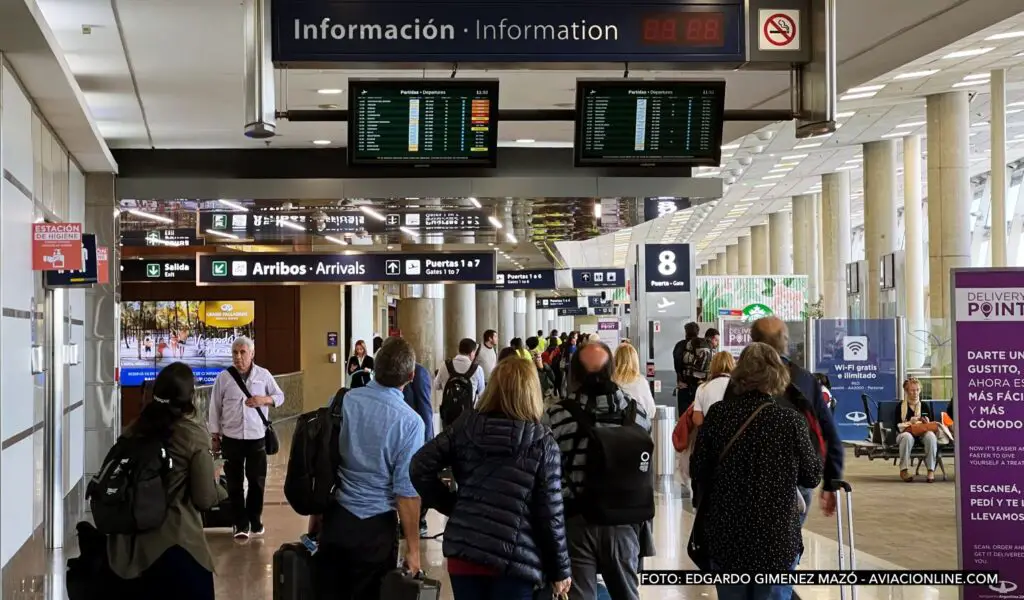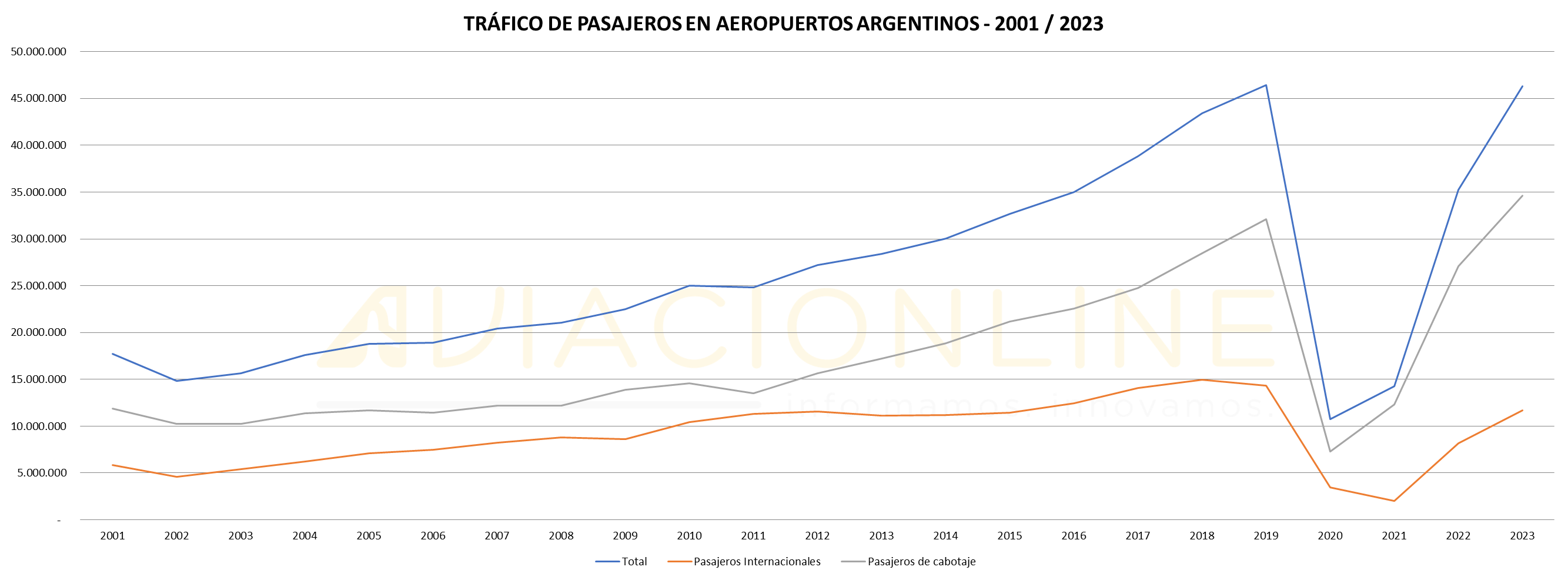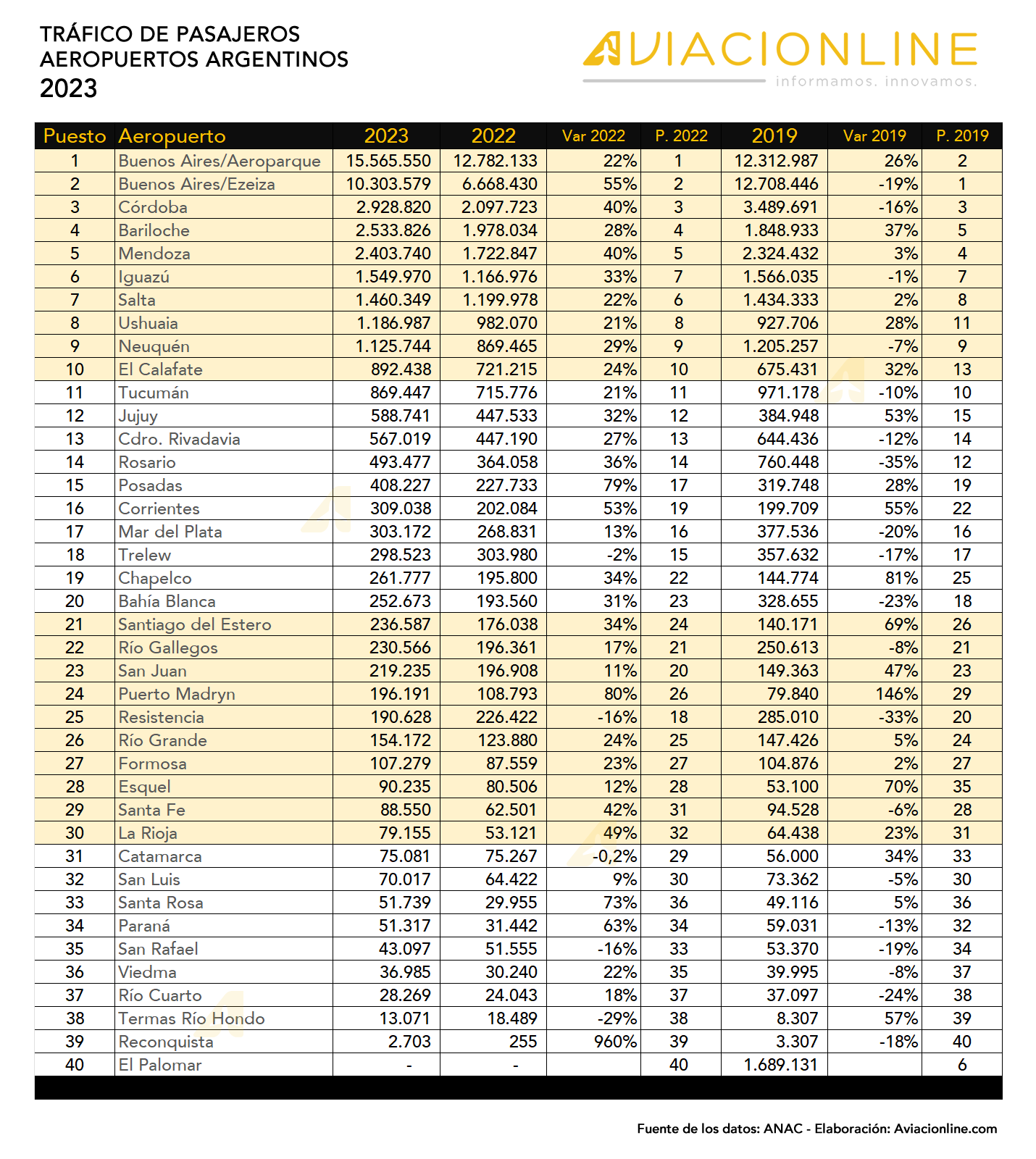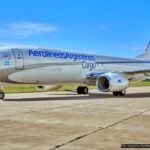In 2023, Argentine airports mobilized a total of 46.43 million passengers, a figure 31% higher than that of 2022 and just 0.3% lower than that of 2019, being on the verge of completing the recovery process after the pandemic.
Of this total, 34.59 million were mobilized in domestic flights, showing double growth both compared to 2022 (+28%) and to 2019 (+8%). The international segment, following the global trend, was the one that still has not managed to recover. Although it grew 44% between 2022 and 2023, it still remained 18% below the 2019 figures, with 11.70 million passengers.
These figures are derived from the data published by the National Civil Aviation Administration (ANAC), compiled by Aviacionline to present this ranking of the Argentine airports with the highest passenger traffic during 2023.

Of the 56 airports included in the ANAC reports, only 40 had regular passenger flights at some point during the year, and these are the ones we will include in the ranking. These represent 99.9% of the recorded passenger traffic. The only one left out of this publication is the Valle del Conlara airport in San Luis, which has been receiving regular flights from Aerolíneas Argentinas since December 2022, but whose statistical information does not appear in the ANAC reports (perhaps being managed by the province they have not yet managed to integrate the information into the Integrated Civil Aviation System).
We could make an estimate considering factors such as that between January and December of 2023, according to information obtained through the Cirium platform, Aerolíneas Argentinas had an offer of 20,480 seats in Merlo (considering arrivals and departures), and with conservative load factors, annualize between 10,000 and 15,000 passengers, but as it is not an exact figure we will not include the Valle del Conlara airport in the ranking.
Key Points of the Passenger Ranking in Argentine Airports during 2023
- For the first time, Buenos Aires Jorge Newbery Aeroparque surpassed 15 million passengers in a calendar year.
- A record number of nine «millionaire» airports was reached, i.e., those that exceeded one million passengers per year: Aeroparque, Ezeiza, Córdoba, Bariloche, Mendoza, Iguazú, Salta, and Neuquén, all of which had already exceeded that figure in 2019, were joined by Ushuaia in 2023 (Neuquén fell during the pandemic and returned to its millionaire status in 2022).
- Additionally, for the first time there are five airports with more than two million annual passengers: Aeroparque , Ezeiza, Córdoba, Bariloche, and Mendoza.
- 20 of the 40 airports with regular passenger flights have already exceeded pre-pandemic passenger figures.
- The airports concessioned to Aeropuertos Argentina 2000 (30 among those with regular flights) accounted for 89% of passenger traffic. They are followed by those of London Supply with 5%, and then various provincial administrations or direct concessions (such as Bahía Blanca and Neuquén, linked to Corporación América, the holding of AA2000).

The Best and the Worst
- Considering total traffic, the top 10 airports with the highest percentage growth compared to 2019, before the outbreak of the pandemic, were Puerto Madryn (+146%), Chapelco (+81%), Esquel (+70%), Santiago del Estero (+59%), Termas de Río Hondo (+57%), Corrientes (+55%), Jujuy (+53%), San Juan (+47%), Bariloche (+37%), and Catamarca (+34%).
- The 10 airports furthest from the 2019 figures are Rosario (-35%), Resistencia (-33%, although it should be noted that it closed for two and a half months in 2023), Río Cuarto (-24%), Bahía Blanca (-23%), Mar del Plata (-20%), San Rafael (-19%), Ezeiza (-19%), Reconquista (-18%), Trelew (-17%), and Córdoba (-16%).
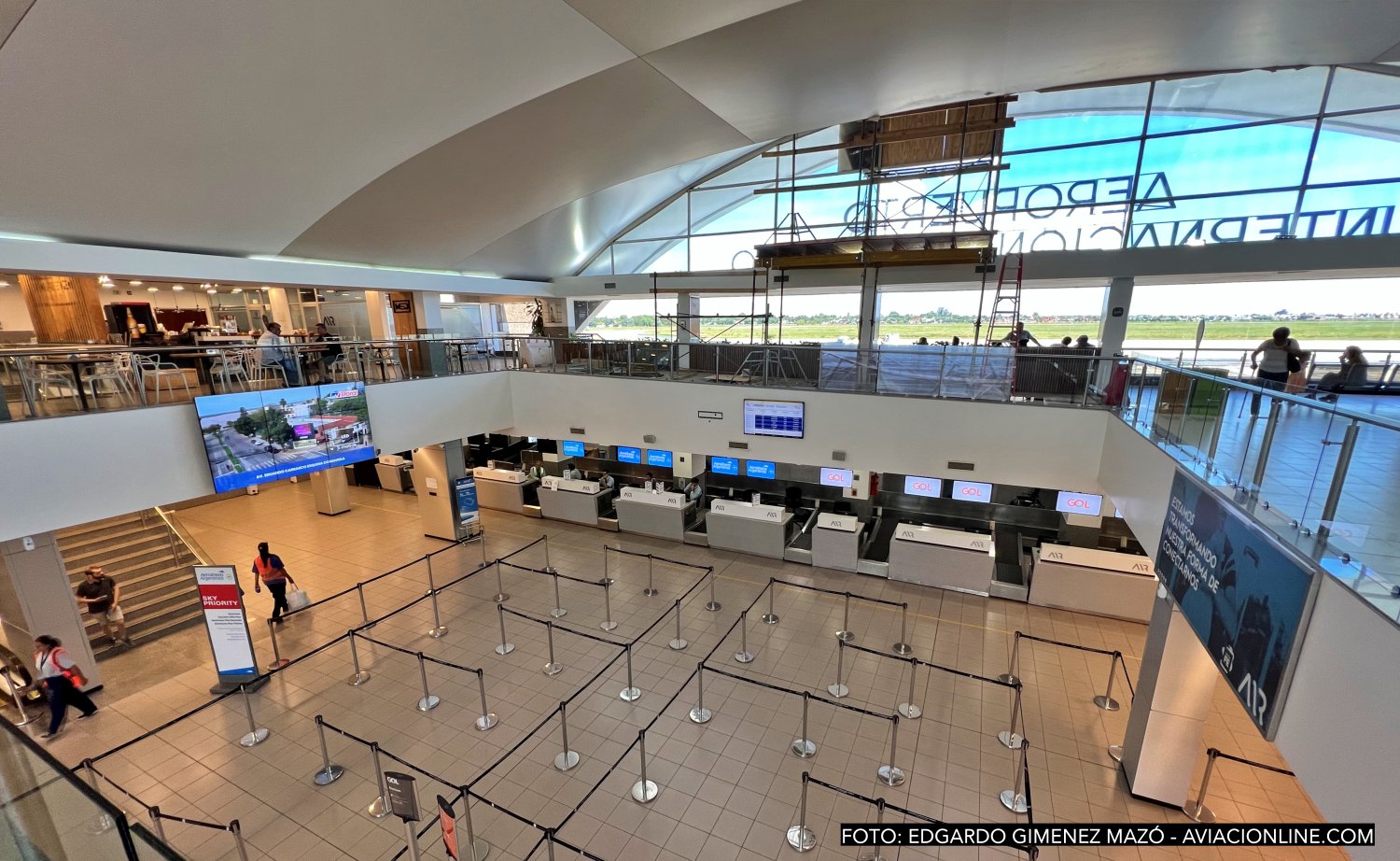
International Traffic, Still in Recovery
- The Mendoza airport became the busiest international airport in the interior of the country, surpassing Córdoba for the first time in this indicator, with 500,332 passengers, just 2% below its 2019 mark.
- The international traffic of Buenos Aires (considering Aeroparque, Ezeiza, and El Palomar, the latter operational until 2020), is still 16% below 2019 levels.
- In the interior, the recovery of international traffic is even slower: in 2023 it remained 32% below 2019 levels, even though it grew 73% compared to 2022.
- The international traffic of the Bariloche airport is showing the best performance post-pandemic, having grown 59% compared to 2019, largely thanks to winter season flights connecting it with Brazil, and new flights of SKY from Santiago de Chile.
- Iguazú and Tucumán are at the other end, as they have not recovered regular international passenger flights. The first, from Air Europa, and the second, from LATAM to Lima.
- Among those that received regular international flights in 2023, Rosario and Salta are the ones with the worst recovery rate compared to 2019, with -60% and -79% respectively. In Rosario, airlines such as LATAM, Azul, and SKY are yet to return, while Salta awaits the return of Copa Airlines.
- The growth of Aeroparque is due to the internationalization process it has been undergoing since 2021. In 2019, it only operated flights to Uruguay.
- Ezeiza’s more pronounced decline is due to the transfer of many international flights to Airpark.
Changes in Domestic Market
- In terms of the domestic market, Bariloche continues to surpass Córdoba and Mendoza, which have historically been in the 2nd and 3rd positions in the interior.
- In the Top 10, there were no major changes between 2022 and 2023, except for a swap between Iguazú and Salta in the 7th and 8th positions.
- The two airports that climbed the most positions between 2019 and 2023 were Esquel (from position 35 to 28), Corrientes (from position 22 to 16), and Chapelco (from 25 to 19). Corrientes was helped by the two and a half month closure of Resistencia.
- There were no major falls except for Resistencia from position 20 to 25, but again, this was due to closure for works between March and May.
- With a 28% growth compared to 2019, the Posadas airport surpassed for the first time the barrier of 400 thousand passengers. It is the first among the capitals of northeastern Argentina to do so.
- The Jujuy airport exceeded half a million passengers for the first time, increasingly narrowing the gap with the other two most important airports in the northwest: Salta and Tucumán.
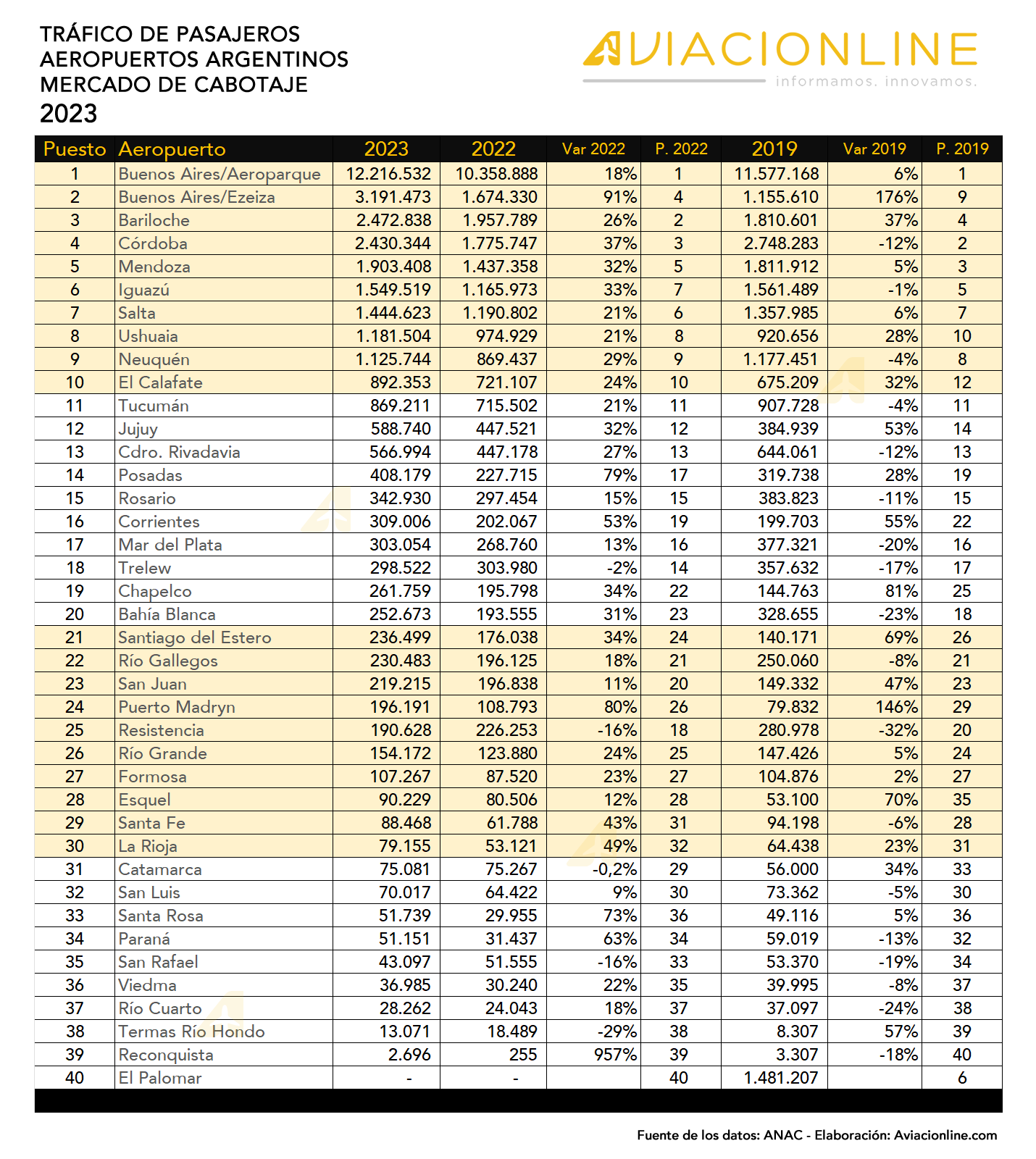
If the trend of recovery and growth of the Argentine commercial aviation market continues in 2024, this year the airports would cross the mark of 50 million mobilized passengers, which would mean having doubled the traffic in 14 years (slowed down by the pandemic, considering that it took 8 years to go from 20 to 30 million and another three from 30 to 40 million).
And although the new government has already established its intention to carry out an open skies policy, its success will not only depend on achieving the political and union consensuses that support it, but also on building a healthy macroeconomy that allows airlines to develop and, most importantly, that Argentine consumers have the resources to travel.

